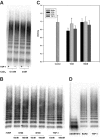The thrombospondin-1 N700S polymorphism is associated with early myocardial infarction without altering von Willebrand factor multimer size
- PMID: 16684956
- PMCID: PMC1895875
- DOI: 10.1182/blood-2006-04-015701
The thrombospondin-1 N700S polymorphism is associated with early myocardial infarction without altering von Willebrand factor multimer size
Abstract
The N700S polymorphism of thrombospondin-1 (TSP-1) has been identified as a potential genetic risk factor for myocardial infarction (MI). In a large case-control study of 1425 individuals who survived a myocardial infarction prior to age 45, the N700S polymorphism was a significant risk factor for myocardial infarction in both homozygous (odds ratio [OR] 1.9, 95% confidence interval [CI] 1.1-3.3, P = .01) and heterozygous carriers of the S700 allele (OR 1.4, 95% CI 1.1-3.3, P = .01). TSP-1 has been shown to reduce von Willebrand factor (VWF) multimer size, and the domain responsible for VWF-reducing activity has been localized to the calcium-binding C-terminal sequence. As the N700S polymorphism was previously shown to alter the function of this domain, we investigated whether the altered VWF-reducing activity of TSP-1 underlies the observed prothrombotic phenotype. The TSP1 N700S polymorphism did not influence VWF multimer size in patients homozygous for either allele nor was there a significant reduction of VWF multimer size following incubation with recombinant N700S fragments or platelet-derived TSP-1.
Figures

References
-
- Topol EJ, McCarthy J, Gabriel S, et al. Single nucleotide polymorphisms in multiple novel thrombospondin genes may be associated with familial premature myocardial infarction. Circulation. 2001;104: 2641-2644. - PubMed
-
- Boekholdt SM, Trip MD, Peters RJ, et al. Thrombospondin-2 polymorphism is associated with a reduced risk of premature myocardial infarction. Arterioscler Thromb Vasc Biol. 2002;22: e24-e27. - PubMed
-
- Zhou X, Huang J, Chen J, et al. Genetic association analysis of myocardial infarction with thrombospondin-1 N700S variant in a Chinese population. Thromb Res. 2004;113: 181-186. - PubMed
-
- Yamada Y, Izawa H, Ichihara S, et al. Prediction of the risk of myocardial infarction from polymorphisms in candidate genes. N Engl J Med. 2002; 347: 1916-1923. - PubMed
-
- Bonnefoy A, Hantgan R, Legrand C, Frojmovic MM. A model of platelet aggregation involving multiple interactions of thrombospondin-1, fibrinogen, and GPIIbIIIa receptor. J Biol Chem. 2001; 276: 5605-5612. - PubMed
Publication types
MeSH terms
Substances
Grants and funding
LinkOut - more resources
Full Text Sources
Other Literature Sources
Medical
Research Materials
Miscellaneous

